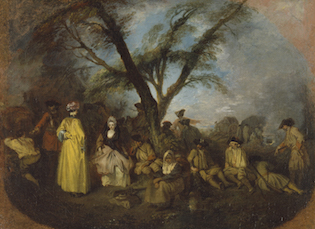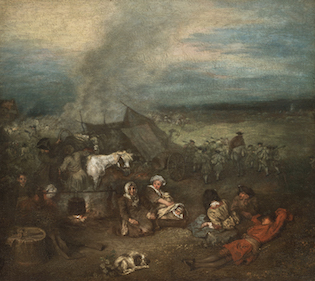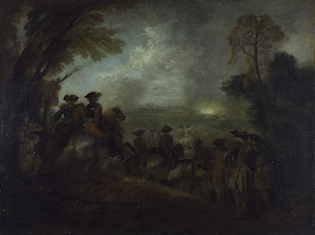Antoine Watteau had a brief but influential career as a painter in France at the turn of the Eighteenth Century. The vast majority of his works are the kind of scenes we have come to expect from that period: powdered aristocrats in landscaped gardens; lovers, also in landscaped gardens; the occasional fête gallante, again, in a landscaped garden. Watteau painted with a cool pallet of muted greens, blues, and yellows, occasionally punctuated by a splash of red on a coat or azure on a vest. Most of the figures he depicted are rendered in only a few layers of paint, giving them an illustrated quality that we now associate with cartoons. It is style of painting, both in form and subject-matter, that readily lent itself to the decoration of tea sets and dinnerware.
But amidst these under-inspiring pictures of aristocratic gaiety, Watteau painted about a dozen scenes of military life. These were based on scores of sketches he composed whilst visiting French Army encampments during the War of Spanish Succession (1701 – 1714), and now Curator Aaron Wile has put together an intriguing exhibit at the Frick called Watteau’s Soldiers.

Watteau’s paintings of military life are not portraits. They are a kind of landscape painting in which people count as part of the scenery. There are never fewer than half dozen individuals placed within the scenes—and I use the word "placed" because that is precisely what Watteau did.
The Frick's exhibit greatly benefits from the paintings co-presentation with Watteau’s sketches. Watteau’s final compositions relied on these sketches with little translation into the context of the scene he is painting. His final paintings were, indeed, landscapes onto which he transplanted his characters in precisely the same poses and with the same expressions that he had captured in his sketches. Watteau sketched a soldier lying on his stomach, who reappears in his painting, Bivouac. Watteau sketched another soldier resting his face on his hand, who reappears in The Halt. Watteau sketched a soldier sitting with a smoldering pipe in his left hand, who reappears in The Portal of Valenciennes.
Despite the restricted effort at integration, transplanting these sketched figures onto the canvas nevertheless achieves a certain realism that Watteau’s posed scenes necessarily lose. He was painting in a world without photography after all, and his paintings of warfare were the closest that his upper-class patrons in Paris would have ever gotten to such things. By rendering the soldiers as he saw them, the civilian world was given a window into military life stripped of pretext and preconception.
There is a cost to this technique, however. Stripping these figures of the context in which they were sketched and dropping them into wholly different places and moments leaves the viewer feeling that they are looking at something uncanny. As Aaron Wile, the exhibit’s curator, demonstrates in the book accompanying the exhibit, none of Watteau’s characters make eye contact. Even when portrayed as speaking to one another, their eye-lines just pass one another. Watteau’s characters are animatronic figures in a diorama.
Wile, the curator, looks at this as a feature, not a flaw. He argues that this is Watteau’s effort to show the soldier’s inner life and alienation when faced with the horrors of war. I am less convinced, though, because the same disconnection (and probably the same technique) is evident in Watteau’s paintings of aristocratic social life. Such paintings were the profit centers of Watteau’s short career and it appears more likely that his military paintings were simply an application of his ordinary methods to this less than ordinary subject.
What we should make of all this? On the one hand, there is something appealing about the presentation of the common soldier in the visual language associated with the aristocracy. In the context of the Enlightenment, the soldier is not part of an invisible uniformed mass. Nor is the soldier a kind of tamed savage or heroic demigod of the kind we see in classical representations of warfare. Instead, we are given encounters with the citizen soldier. The soldier is neither lionized nor pitied. The soldier reclining against a tree trunk at camp is no different than the nobleman reclining on a divan at a salon. The encampments are the soldiers’ fêtes galantes.

If that is Watteau’s intention, there is something charming about it. The aristocratic madams and mademoiselles in Watteau’s rococo garden parties are replaced in his military paintings by the wives, maidens, and prostitutes of the citizen classes. Indeed, the most striking aspect of Watteau’s military scenes is the seeming omnipresence of women and infant children, most of whom we are led to believe were fathered at previous encampments.
But I am less sure. Watteau’s look at soldiers came at a great turning point in military history: the era of Louis XIV, the Sun King, when reliable firearms made the lifelong crafts of swordsmanship and archery obsolete. This technological shift had profound effects on tactics, strategy, and the status of the soldier. In the middle of Seventeenth Century, the French Army would field armies of professional soldiers numbering in the tens of thousands. When Louis XIV undertook the War of Spanish Succession only a few generations later, the French Army counted half-a-million men.
This rapid expansion of the Army—both necessitated and made possible by the gun—empowered more men to take up arms. Generalship became less an exercise in personal bravery than a task of bureaucratic management. And the quality of fighting men as warriors declined as the supply increased. This can be seen in Watteau’s Recruits Going to Join the Regiment in which we see eight new soldiers meandering behind an officer on horseback. Watteau’s technique of transplanting his sketched figures into the desired context works exceptionally well in this piece, conveying what a ragtag group of amateurs this really is. The eight men carry their rifles like cumbersome packages. Some use their swords like walking canes. Others appear to be carrying actual walking canes. Each man’s pose is uniquely his own as he goes on a stroll that no one could confuse for marching.
Watteau gives an upper-class audience an upper-class view of soldiers and war. Watteau’s vantage point is not the perspective of a man in the field, confronted with the horrors of increasingly mechanized battle. The moments he captures are all of life far behind the front lines. In all of his paintings, the battlefield is smoldering at a safe distance, recognizable only as a smear of yellow fire from which grey smoke rises and mixes with the clouds. Watteau is in the rear with the resting, the injured, and the camp followers. He is the Eighteenth Century embedded reporter, technically in the war zone, but whose perspective is limited by the equivalent of the Green Zone.

Watteau’s point of view is not obviously sympathetic either. Louis XIV had reformed the French Army from a basically mercenary enterprise into a national standing army. And for a variety of reasons, the growing class of citizen soldiers was a source of anxiety for aristocrats in France’s increasingly unstable class system.
While we tend to see Watteau’s interest in depicting the lives of the lower classes as presciently egalitarian, it is hardly clear that this was the message his audience received. In the Portal of Valenciennes, which is the most technically accomplished of Watteau’s military paintings, the center of the action is a circle of three resting soldiers in the painting’s bottom right corner. There is a fourth figure in their circle, however; an androgynous looking but apparently female figure smoking the kind of long-stemmed pipe associated with opium. The figure appears barely dressed, hair tousled, and her complexion is given a greenish hue to suggest venereal disease. To their side are a drum and a gun, tossed next to a dog, that traditional icon of fidelity, who is sleeping.
What was this scene meant to inspire in Watteau’s aristocratic patrons? Is it meant to help them relate to the soldiers’ interiority? Or is Watteau trading on the comic cliché of the indolent masses?
I cannot say that I am confident about either answer. Though I doubt that Watteau was being consciously satirical. Well-meaning reporters regularly file "slice of life" stories that depict U.S. service-members eating Taco Bell in Afghanistan, or jamming on guitars in Iraq, or walking the aisles of a Walmart just home from deployment. Only 7 percent of Americans have served in the military in any capacity, which is large enough to be visible, but small enough to make the military the same kind of sub-culture that it had become in France during the reign of Louis XIV. Do these portraits make military life relatable to those parts of society which have had no meaningful contact with it? Or do they portray the soldier with a folksy docility, so that society’s wars—the military’s very purpose—can be a smoldering abstraction in the background of landscape painting?
